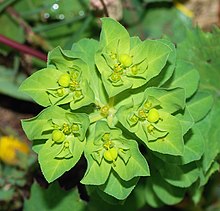
Back Euphorbia Afrikaans فربيون Arabic فربيون ARZ Südləyən Azerbaijani سوتلوجه AZB Малачай Byelorussian ইউফরবিয়া Bengali/Bangla Euphorbia BS Eufòrbia Catalan Euphorbia CEB
| Euphorbia | |
|---|---|

| |
| Euphorbia serrata | |
| Scientific classification | |
| Kingdom: | Plantae |
| Clade: | Tracheophytes |
| Clade: | Angiosperms |
| Clade: | Eudicots |
| Clade: | Rosids |
| Order: | Malpighiales |
| Family: | Euphorbiaceae |
| Subfamily: | Euphorbioideae |
| Tribe: | Euphorbieae |
| Subtribe: | Euphorbiinae Griseb. |
| Genus: | Euphorbia L. |
| Type species | |
| Euphorbia antiquorum | |
| Subgenera | |
|
Chamaesyce | |
| Diversity | |
| c. 2008 species | |
| Synonyms[1] | |
|
List
| |

Euphorbia is a large and diverse genus of flowering plants, commonly called spurge, in the family Euphorbiaceae.
Euphorbias range from tiny annual plants to large and long-lived trees,[2] with perhaps the tallest being Euphorbia ampliphylla at 30 m (98 ft) or more.[3][4] The genus has roughly 2,000 members,[5][6] making it one of the largest genera of flowering plants.[7][8] It also has one of the largest ranges of chromosome counts, along with Rumex and Senecio.[7] Euphorbia antiquorum is the type species for the genus Euphorbia.[9] It was first described by Carl Linnaeus in 1753 in Species Plantarum.
Some euphorbias are widely available commercially, such as poinsettias at Christmas. Some are commonly cultivated as ornamentals, or collected and highly valued for the aesthetic appearance of their unique floral structures, such as the crown of thorns plant (Euphorbia milii). Succulent euphorbias from the deserts of Southern Africa and Madagascar have evolved physical characteristics and forms similar to cacti of North and South America, so they are often incorrectly referred to as cacti.[10] Some are used as ornamentals in landscaping, because of beautiful or striking overall forms, and drought and heat tolerance.[6][2]
Euphorbia all share the feature of having a poisonous, latex-like sap and unique floral structures.[6] When viewed as a whole, the head of flowers looks like a single flower (a pseudanthium).[6] It has a unique kind of pseudanthium, called a cyathium, where each flower in the head is reduced to its barest essential part needed for sexual reproduction.[6] The individual flowers are either male or female, with the male flowers reduced to only the stamen, and the females to the pistil.[6] These flowers have no sepals, petals, or other parts that are typical of flowers in other kinds of plants.[6] Structures supporting the flower head and other structures underneath have evolved to attract pollinators with nectar, and with shapes and colors that function in a way petals and other flower parts do in other flowers. It is the only genus of plants that has all three kinds of photosynthesis, CAM, C3 and C4.[6]
- ^ "Euphorbia L." Plants of the World Online. Board of Trustees of the Royal Botanic Gardens, Kew. 2017. Retrieved 7 July 2020.
- ^ a b "Euphorbia". Fine Gardening. The Taunton Press, Inc.
- ^ Brenan, J.P.M.; Greenway, P.J. (1949). Check-lists of the Forest Trees and Shrubs of the British Empire #5 - Tanganyika Territory. Oxford, England: Imperial Forestry Institute. p. 214 (part 2).
- ^ Hargreaves, Bruce (n.d.). "Euphorbia ingens in Malawi...etc". Euphorbia Journal. 7: 78 plus diagram p. 63.
- ^ "World Checklist of Selected Plant Families (WCSP)". Kew Science. Royal Botanic Gardens, Kew. Retrieved 16 Apr 2011.
- ^ a b c d e f g h "Euphorbia PBI - Project Description". Planetary Biodiversity Inventory (PBI). Retrieved 1 Feb 2019.
- ^ a b Stebbins GL, Hoogland RD (1976). "Species diversity, ecology and evolution in a primitive Angiosperm genus:Hibbertia (Dilleniaceae)". Plant Syst. Evol. 125 (3): 139–154. Bibcode:1976PSyEv.125..139S. doi:10.1007/BF00986147. S2CID 27820065.
- ^ "Euphorbia botany lesson". Houzz. 30 Jun 2010. Retrieved 1 Feb 2019.
- ^ Carter S (2002). "Euphorbia". In Eggli U (ed.). Dicotyledons. Illustrated Handbook of Succulent Plants. Vol. 5. Springer. p. 102. ISBN 978-3-540-41966-2.
- ^ "Cacti or Not? Many succulents look like cacti, but are not". CactiGuide.com. Retrieved 1 Feb 2019.